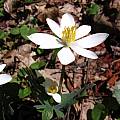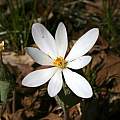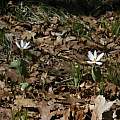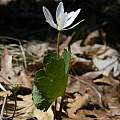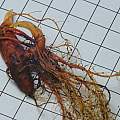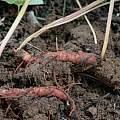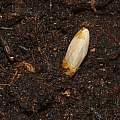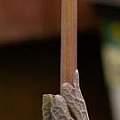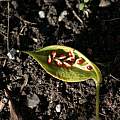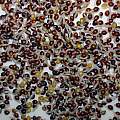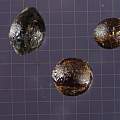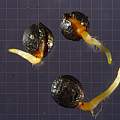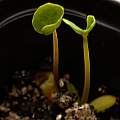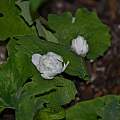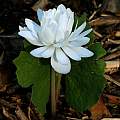Sanguinaria Dill. ex L. is a genus of the family Papaveraceae. Sanguinaria canadensis is the only species in the genus. The plant is found throughout the eastern United States into eastern Canada. It grows in forested areas which have not been disturbed. Plants flower in the spring after a freezing winter dormancy. Attached to seeds are elaiosomes, fleshy bodies made of mostly lipids and proteins. Ants carry these particles back to their nest for food and thus spread and plant the seed simultaneously. The common name bloodroot comes from the red sap that leaks out when the root, more technically a rhizome, is cut. Native American and modern day settlers have made use of this plant in cultural and medicinal practices. The sap is very poisonous and kills tissue, an important activity which is being investigated for anti-tumor activities.
Sanguinaria canadensis L. or Bloodroot is a beautiful plant with powdery blue leaves and a very clean white flower with yellow stamens. Height range: 15-25 cm. Photo 1 taken by Nhu Nguyen April 10, 2006 in the Great Smoky Mountains National Park. Photos 2-5 were taken in habitat in Minnesota.
Photos 1-3 show the root system of the plant. The photos 1-2 & 4-5 were taken by David Pilling. Photo 3 was taken by Nhu Nguyen. Photos 1 and 2 are of commercially supplied roots on a 10 mm grid; photo 4 shows a flower bud.
Photo 1 & 2 by Nhu Nguyen show seeds inside a pod that just opened and a large harvest of seeds harvested from a friend's garden, still with their elaiosomes attached. The elaiosomes are quickly found by ants and carried away along with the seeds into the ground. Photographs 2-4 by David Pilling show seed and germinating seed on a 1 mm grid in Autumn 2013. Seed was obtained from Gardens North in January 2009; it came moist packed. It is said seed should not be allowed to dry out and exposure to gibberellins from woodland soil or leaf litter are needed for germination. This seed had been kept moist and at outdoor temperatures.
Sanguinaria canadensis timelapse by David Pilling taken between 15:30 and 18:11 on the 17th March 2014. Flower closes as the sun sets and temperatures drop.
Sanguinaria canadensis 'Flore Pleno', is a double form, also referred to as f. multiplex (E.H.Wilson) Weath. Photographs by Caroline Langensiepen and Martin Bohnet.
